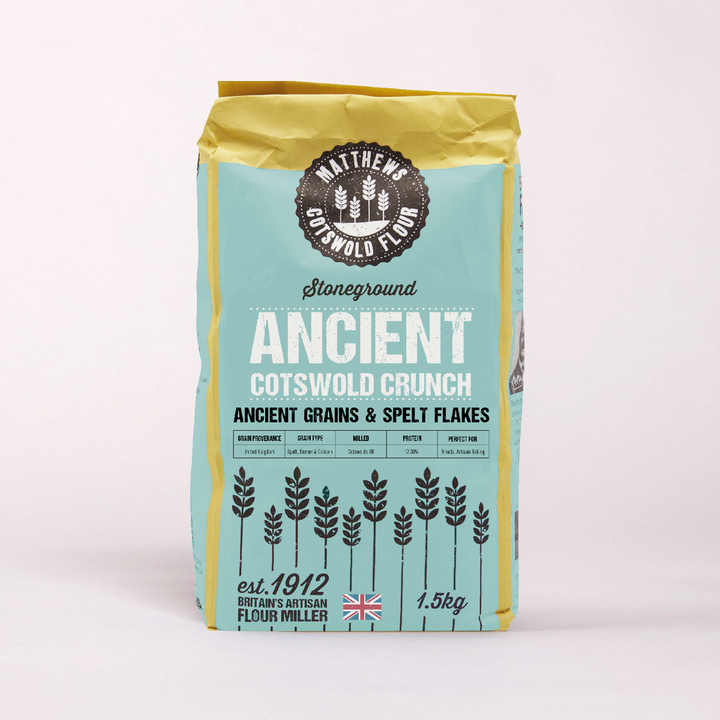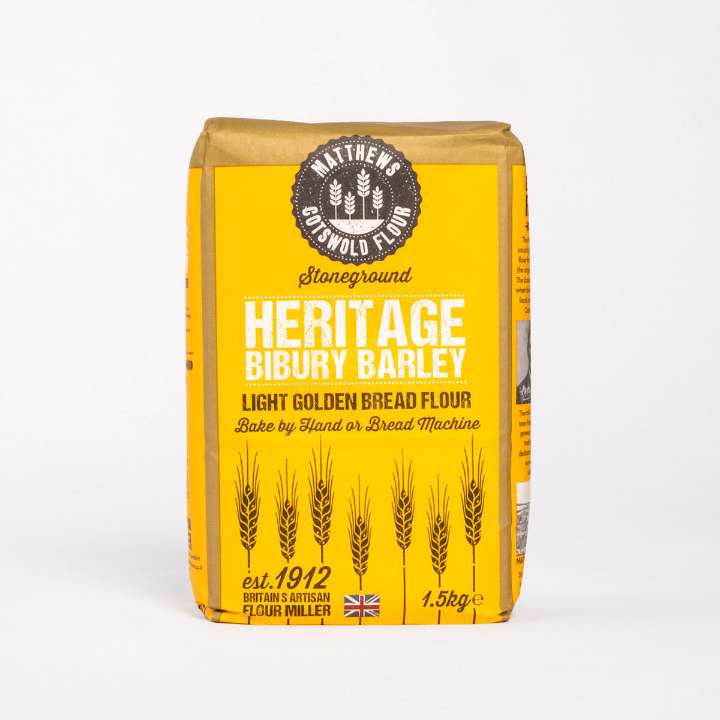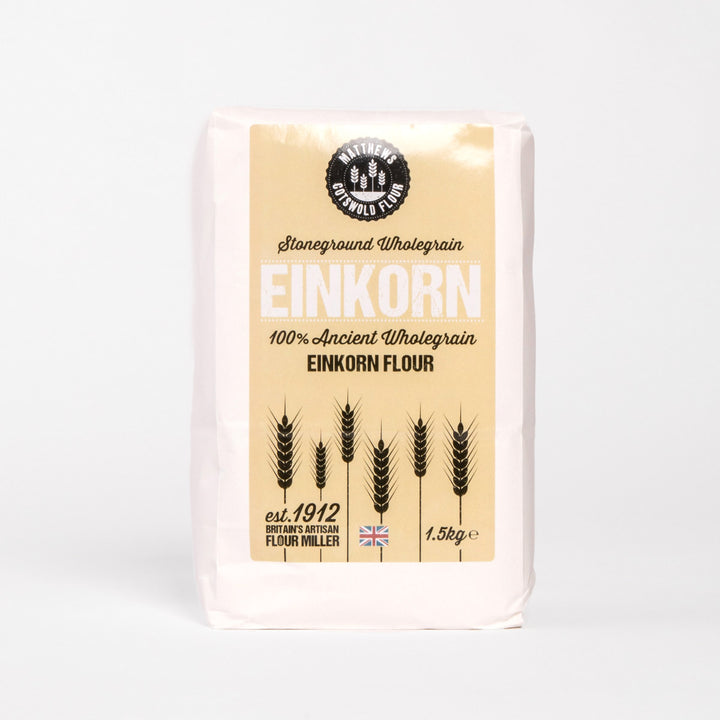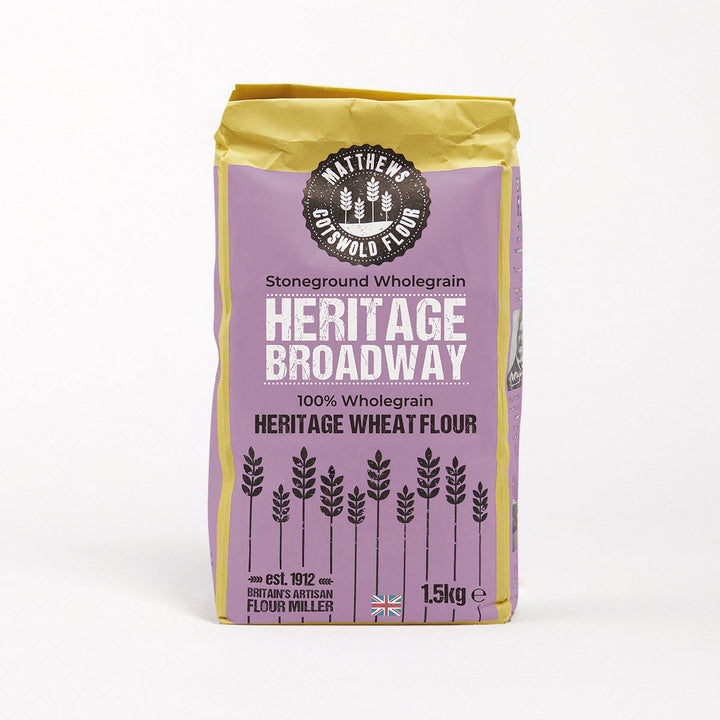Ancient Grains from Matthews Cotswold Flour


“Ancient grains have fascinated bakers across the globe. These old varieties of grain with their unique unmodified genitive profile are a great addition to bakers. At Matthews, our vision is to create delicious baking flour that enhances taste, nutrition understanding and experience. We have chosen 4 ancient grains and have traditionally milled them in the Cotswolds using our milling stones George and Marmaduke.
We have written details on each grain - its history, profile, and baking tips. We hope you enjoy these fantastic flours as much as we have milling them for you.”
Bertie Matthews - Managing Director, Matthews Cotswold Flour
What are Ancient Grains?
Ancient Grains is a term used to describe the 4 original domesticated wheats, grains and pseudocereals. The four main Ancient grains used in baking flour are Einkorn, Emmer, Spelt and Khorasan. The species are often 8000 to 10000 years old as opposed to modern varieties of grain which could be only a few decades and heritage varieties of wheat which would be hundreds of years. Other Ancient grains include Amaranth, Barley, Freeka, Quinoa, Millet and Buckwheat.
What is different about Ancient Grains?
They are the oldest of grain species and all modern wheat is descended from these grains. They are generally untainted by modern modification and therefore can be a more diverse alternative to modern monoculture crops. The three original “Farro” which is an Italian term for these varieties are
- Farro Piccilo (Einkorn) (Piccilo = Small) (The grandfather of all grains)
- Farro Medio “Emmer” (Medio = Medium)
- Farro Grande “Spelt” “Grandson” (Grande = Big)
What is so good about Ancient Grains?
Ancient grains are becoming more popular, they are often less refined and less processed than modern varieties of wheat. This is particularly true in their wholegrain form. Ancient grains in their wholegrain form contain a significant amount of vitamins, minerals and fibre than more common cereals like corn, rice and modern wheats.
What are the different Ancient Grains?
Below is a list of types of ancient grains and pseudocereals. It should be pointed out that there are modern varieties of all of these grains, there original ancestors where the true “Ancient Grains”
Einkorn

What is Einkorn?
Einkorn is an ancient variety of wheat and is referred to as “The mother of all grains”. Einkorn's name derives from the fact that it only has one grain on each ear. The word Ein comes from the German word for “One”. Einkorn is also called “Farro Piccolo” in Italian meaning small. It is the smallest of the three “farro” grains. Einkorn originally grew wild in the fertile crescent 10,000 years ago. Einkorn is referred to as an ancient grain as it has been cultivated for more than 10000 years in central and southern Asia as well as Europe.
What is Einkorn Flour? Einkorn flour is milled from Wholegrain Einkorn. It can come in a wholegrain form or can be milled into a light Einkorn. The flour is very rich in flavour and produces a hearty slightly nutty flavour that adds to your baking recipes.
How to use Einkorn? We recommend using Einkorn flour the same way you would use other wholegrain or wholemeal flours. For best results choose recipes where there is little shaping involved. When making wholegrain bread recipes Matthews advises reducing the amount of liquid in your dough by 20% to 30%. Hold back from adding more flour to keep the balance. Watch out for over mixing, Einkorn has a much faster mixing time due to its lower gluten quality than other flours. If you are looking for a more artisanal crust use a dutch oven when baking.

What can I bake with Einkorn flour? Einkorn flour can be used in a number of recipes on its own or blended with other Cotswold flour strong bread flours for a lighter bake:
- Elaine Foodbod’s Oat Crusted Einkorn Master Loaf
- Einkorn Wholegrain Bread
- Einkorn Banana Bread
- Einkorn Pancakes
- Einkorn Waffles
Looking for Einkorn Flour? Try Matthews Cotswold Flour Ancient Grain Flour (Wholegrain Einkorn, Ancient Cotswold Crunch)
Looking to grow Einkorn? The Cotswold Grain Partnership has been growing Einkorn in the UK for the last few years. If you are a farmer looking to try this ancient grain, then please sign up to the Cotswold Grain Partnership.
|
Names |
“Einkorn” / Farro Piccilo / Little Spelt /escanda meno |
|
Scientific Name |
Triticum boeoticum Or (Triticum monococcum) |
|
Age |
10,600BC > 9,900BC |
|
Origin |
Çayönü Turkey, “Fertile Cresent” |
|
Einkorn Flour |
Einkorn flour has a slightly yellowish colour and has a higher nutritional value than modern varieties. The volume of bakers can be lower due to lower protein strength, but this can be countered by blending with Churchill or another strong white flour. Einkorn mixing time is much faster. |
|
What to bake with Einkorn |
|
|
Flour with Einkorn |

Shop Matthews Cotswold Wholegrain Einkorn Flour
Emmer
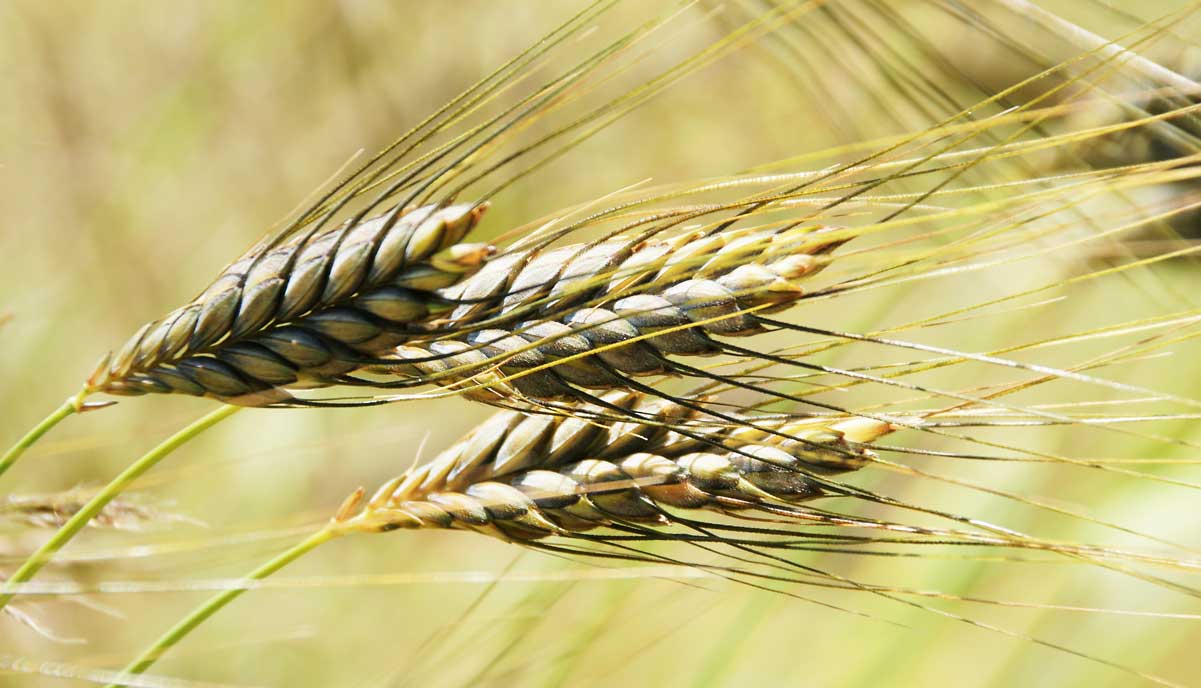
What is Emmer? Emmer wheat (Triticum dicoccum) is a relative of Einkorn and ancient Durum wheats. Known as “Farro Medio '' in Italy as its size is between Einkorn and Spelt. Emmer is a hulled grain as it retains its hull during harvest. Wholegrain Emmer can be used in pasta recipes or blended into bread recipes. Emmer was brought over to Italy by the Romans when they invaded Egypt in 47BC. It is said that Julius Caesar nicknamed Emmer wheat as “Pharaoh’s Wheat”. It played a huge part in feeding the Roman legions. Today Emmer is more of a relic crop in favour of higher yielding wheats. However, Emmer is still grown on a much smaller scale around Europe and in the mountain regions of Italy.
What is Emmer Flour? Emmer flour is flour produced from milling ancient Emmer grain. The flour is a darker yellowish colour when compared to modern bread wheats. The flour is traditionally stoneground milled from the wholegrain to retain its strong nutritional qualities.
How to use Emmer Flour? Emmer flour, like other ancient grains, is rich in flavour. It has a delicious nutty wheat flavour. Emmer flour can be used in its wholegrain form to replace a wholewheat flour. However due to its lower gluten quality you may wish to blend with flours with strong gluten quality. To get the best results with emmer we recommend blending with stronger gluten quality flours like Matthews Cotswold Strong White Flour or Churchill Bread Flour.
Early breads made with Emmer in Italy included flatbreads, pita and focaccia. Because of its lower gluten quality, Emmer bread like Einkorn and Rye is much denser.
Emmer Baking Top Tip 1: Bread dough can be stickier because of the weaker gluten. Do not over knead or add flour as this will not help. Accept the stickiness and knead the dough to a level where it is soft and pliable, rather than super stretchy.
Emmer Baking Top Tip 2: Bake your dough in a well-greased tin rather than a baking sheet. This will help when taking the dough out of the pan.
Emmer Baking Top Tip 3: Work the dough firmly but gently or the dough will break up.

What can I bake with Emmer Flour? Emmer flour can be blended into your recipes at 20% or used on its own to make:
- Elaine Foodbod’s Emmer and honey sandwich loaf
- Ancient Emmer Pasta
- Emmer Bread
- Emmer Pancakes
- Wholegrain Emmer bread
|
Names |
“Emmer” / Farro Medio |
|
Scientific Name |
Triticum dicoccon |
|
Age |
7000>9700 BC |
|
Origin |
Fertile Crescent, modern day Iran, Iraq, Turkey. |
|
Flour Description |
Emmer is a darker looking yellowish flour with a nutty taste to it. |
|
What to bake with Emmer |
Emmer and honey sandwich loaf Emmer Bread Emmer Pancakes Wholegrain Emmer bread |

Shop Matthews Cotswold Wholegrain Emmer Flour
Spelt
What is Spelt? Spelt (Triticum Spelta) known in Italy as “Farro Grande” is an ancient wholegrain. Along with Einkorn, Emmer and Khorasan is considered an Ancient Grain and is also a “hulled Wheat” which protects the nutrients in the bran and germ. has been cultivated for thousands of years. It is high in dietary fibre and contains important vitamins and minerals. Spelt is high in fibre which is important for managing cholesterol. Fibre in Spelt can help you to digest food faster. Spelt even appears in Greek Mythology as a gift from Demeter to the goddess of agriculture
What is Spelt Flour? Spelt flour is milled using ancient spelt wheat after it has been de-hulled. Spelt flour can be in its wholegrain form best traditionally milled using all of its nutritious bran, endosperm and germ. Spelt can also be milled as “Light” or “White” spelt with 22% of the grain removed to leave a pure soft white flour great for all-purpose baking.
Spelt flour has a beautiful nutty, slightly sweet flavour. Spelt wholegrain variant is visibly more bran with bran flakes in it. Spelt flour's texture is similar to that of wheat flour. It can be used as an all-purpose flour and mixed into baking recipes.
How to use Spelt Flour? Spelt flour is a great all-purpose flour. It can be blended at 20% to your baking recipes or used on its own. Spelt flour has strong gluten content however it has a higher proportion of gliadin to glutenin (Two core proteins that make up gluten) which means that gluten can be less resilient than a modern wheat flour.
Spelt Baking Top Tip 1: Do not over mix spelt dough, the gluten can start to break down. Best technique is to avoid over mixing or over kneading.
Spelt Baking Top Tip 2: Spelt flour is slightly more water soluble than wheat flour. We recommend reducing the water in the recipe by 20%>25%.
Spelt Baking Top Tip 3: When first baking with spelt try blending Spelt into your recipes at about 25%>50%. You can do this with any white bread, wholegrain bread or other baking recipes.

What can I bake with Spelt Flour? Spelt can be replaced using a 1 to 1 ration in many baking recipes. For breads however you will want to blend with a higher gluten quality flour like Churchill or stoneground wholegrain for darker breads.
Spelt flour available to buy:
Matthews Cotswold Wholegrain Dark Spelt: 100% Wholegrain spelt is traditionally stoneground milled, delivering a beautiful nutty slightly sweet all-purpose flour. Rich in flavour, our wholemeal spelt flour is a great healthy option, being easier to digest than normal flours as it is not made with standard wheat and is in fact and ancient grain.
Matthews Cotswold White Spelt: White Spelt flour is a smooth white flour milled from UK grown ancient grain spelt. This flour is much lighter in feel and easier to work with than wholegrain ancient grain flours. This flour produces easier to rise breads with the distinctive nutty and sweet spelt flavour. Spelt is a highly nutritious and healthy option, compared to wheat, it is packed full of fibre. Cotswold Spelt is a perfect all-purpose healthy baking flour that produces delicious bread, cake and biscuit recipes.
Matthews Cotswold Spelt and Rye: Matthews Stoneground Cotswold Spelt and Rye is a Blend of Wholegrain Cotswold Rye & Cotswold Light Spelt flour. It produces a lighter wholemeal blend flour from two nutritious grains. Our Stoneground Spelt and Rye delivers a mild, nutty dark flavour.

|
Names |
“Spelt” / Farro Grande / Dinkle Wheat / |
|
Scientific Name |
Triticum spelta |
|
Age |
5000BC+ / Britain 2000BC |
|
Origin |
Ancient Mesopotamia, modern day Iraq / Iran |
|
Flour Description |
100% Wholegrain spelt traditionally stoneground milled delivering a beautiful nutty slightly sweet all-purpose flour. Rich in flavour, our wholemeal spelt flour is a great healthy option, being easier to digest than normal flours as it is not made with wheat and is in fact and ancient grain. |
|
What to bake with Spelt |
Cotswold Spelt and Rye Loaf Wholemeal Spelt Bread |
Shop Matthews Cotswold Spelt Flour
Khorasan
Khorasan (Triticum turanicum) is an ancient grain from the Persian region of the same name Khorasan now in Iran. Khrosan is one of the earliest types of wheat, it is a relative of ancient durum first grown in the “fertile crescent” the birthplace of agriculture around Mesopotamia thousands of years ago. Matthews Khorasan is from an ancient Italian variety including “Perciasacchi” which is one of the oldest conversions from durum. It has been farmed using a low input farming model in Italy. The wheat once referred to as “Wheat of the Pharaohs” or “king Tut’s Wheat” indicates when it was used by and by who. One thing is for certain Khorasan is very tall with deeper route systems supporting its nutritional requirements. The nutritional value of the grain has been maximised by slowly stoneground milling the grain into a dark wholegrain flour. This traditional method of milling maintains the nutritious bran and germ within the grain berry.
What is Khorasan flour? Khorasan flour is a flour produced by milling ancient Khorasan grain. This can be milled into its wholegrain form or can be more finely milled into a white Khorasan flour. Khorasan is an ancient relative of durum wheats and is also descended from Emmer and Einkorn. Matthews Khorasan has a stronger flavour than some other Khorasan varieties. It is slightly pale off white and slightly golden in colour. Khorasan has a high proportion of carotenes and selenium and has a rich buttery taste and can be used in a number of different baking recipes.

How to use Khorasan flour?
Khorasan Baking Top Tip 1: For bread recipes try using 40%>50% Khorasan flour with a stoneground high protein flour or a white bread flour like Churchill or Strong white. Alternatively blend your Khorasan into your all purpose or bread baking at 20%>30% for added flavour to your bakes.
Khorasan Baking Top Tip 2: Khorasan flour is a thirsty one, it can absorb 25% more water than wheat flour. Matthews recommends adding slightly more water to your dough.
Khorasan Baking Top Tip 3: Khorasan flour It can be denser when baking so baking brownies, biscuits and other baked goods that do not need to rise much are a good choice.
What is Kamut®: Kamut® is a brand name for Khorasan trade marked by the USA and Canada company “Kamut international” a company founded by Montana based farmer Bob Quinn. Bob wanted to protect the quality and genetic purity of wheat. The names Kamut ® and Khorasan (A region in the middle east) are said to derive from the Egyptian word for wheat.
|
Names |
“Khorasan” / KAMUT® / Oriental wheat |
|
Scientific Name |
Triticum turanicum or Triticum turgidum |
|
Age |
5000BC+ / Britain 2000BC |
|
Origin |
Ancient Mesopotamia, modern day Iraq / Iran |
|
Flour Description |
Traditionally stoneground milled Ancient Wholegrain Khorasan. Delicious creamy yellow, with a clean buttery flavour. Substitute around 50% for normal wholemeal flour for added flavour in your bakes. |
|
What to bake with Khorasan |
Khorasan and Golden Flaxseed Master Loaf Wholemeal Khorasan Bread Ancient Grain Pasta Ciabatta Bread Khorasan Pancakes |

← Older Post Newer Post →

